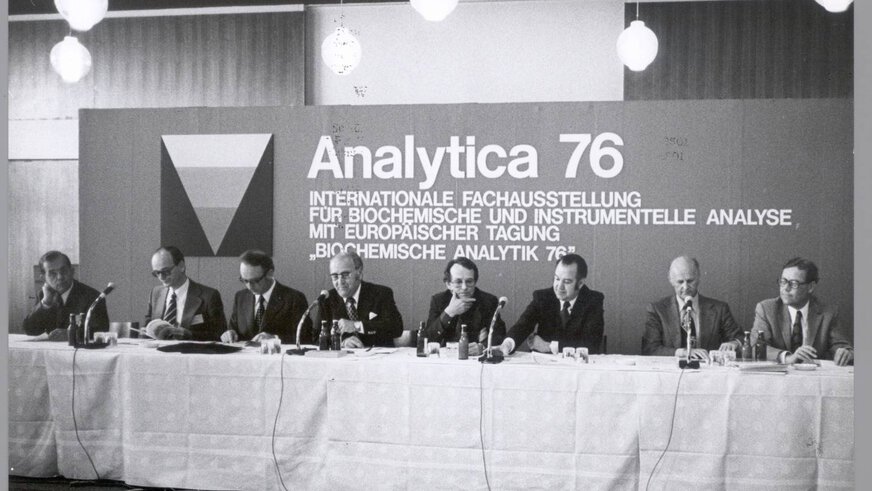History of analytica
In 1968, a manned space capsule circled the moon for the first time, Germany introduced value added tax, and young people all over the world revolted against the prevailing circumstances. The analytics sector was also on the verge of a new era: in April of 1968, the analytica celebrated its premiere in Munich, back then it was still called “ANALYTICA—International Trade Exhibition for biochemical analyses”.
50 years of analytica—the success story in pictures








The milestones of analytica’s history
1968: The analytica celebrates its premiere with 90 exhibitors on a gross area of 5,000 square metres and 4,000 visitors from 17 countries. The accompanying conference “Biochemical Analysis” welcomes more than 800 industry visitors.
1972: Already at the third analytica, all figures of the first event have more than doubled: more than 9,400 visitors flock the analytica in Munich on a gross area of 9,000 square metres.
1976: The analytica has meanwhile established itself as the lead international trade fair. 13,308 visitors from 21 countries can learn all about the industry innovations on nearly 21,000 square metres of exhibition space.
1992: A premiere at the analytica Munich: the first special show on an area of 182 square metres.
1998: The analytica relocates to the new exhibition grounds in München-Riem.
2002: For the first time, more than 1,000 exhibitors attend the exhibition.
With the analytica China the trade fair takes the first step onto one of the most important analytical markets of the world.
2003: The industry ventures into another important growth market with the analytica Anacon India.
2009: analytica Munich and IMAG GmbH host the first analytica Vietnam in Hanoi.2012
Live presentations in fully equipped Live Labs are held for the first time and become an outstanding success at the analytica in Munich.
2014: The international exhibition network of the analytica continues to grow: the analytica Anacon India takes over the India Lab Expo.
2016: The leading international trade fair for laboratory technology, analytics and biotechnology breaks all records: 1,244 exhibitors, 37 percent of which from abroad, present their innovations and future trends on the exhibition grounds in Munich.
2017: The analytica cluster continues its path of expansion: this time with the Lab Africa, which will take place for the first time under the auspices of the analytica cluster in 2019.
2018: The analytica 2018 paves the way for digitization in the laboratory industry: the new Forum Digital Transformation offers panel discussions, live demonstrations and sessions to become fit for the smart lab.
The full history of the analytica
Analytica has been supporting the development of chemical analytics and bioanalytics for 50 years. And more: It stimulates the transfer of technology and expertise, as it brings together equipment manufacturers and laboratory analysts, scientists and users. Analytica has thus been driving the progress of analytics for half a century by now.
One look back shows how fundamentally the industry has changed since 1968: When the first analytica took place, many laboratory devices still had analogue displays. There were no computers for automatic data collection, no high performance liquid chromatography (HPLC), and no coupling of gas chromatographs with mass spectrometers yet. Bioanalysts were not able to sequence genes yet. But many ideas were buzzing around. Undoubtedly, the industry needed a meeting place to exchange, to drive new developments, and to keep abreast of the latest developments. Thus, the very premiere of analytica in April 1968 was already a complete success.
5,000 visitors from 24 countries and 90 exhibitors from ten European countries met in Munich from April 29 to May 2, 1968, at the first “ANALYTICA—International Specialist Exhibition for Biochemical Analysis” (or in the German original: „ANALYTICA Internationale Fachausstellung für biochemische Analysen“), which covered a total area of 5,000 square meters (1¼ acres) on the old trade fair grounds at the Theresienwiese in Munich (widely known as the location of the Oktoberfest). Quickly the decision was made: The new trade fair was going to be held every two years. Four years after the launch, it had already increased its visitor number to 9,400; in 1976 more than 13,000 people interested in analytics flocked to Munich, and by 1978 the number was approaching 20,000. Today, analytica has not lost any of its attractiveness: Analytica 2016 welcomed 35,002 visitors from 119 nations.
There was never a dearth of highlights at analytica: In the 1980s, new developments in gene and protein analysis were in the focus, above all the first DNA sequencers. In the 1990s, the call for miniaturisation and automation became louder and louder. Previously bulky analysers shrank to shoe box size or even chip format; the computer became the partner of all analytical devices. At the 1990 analytica, for example, visitors could learn about laboratory information and management systems. Finally, analysis systems by various vendors and computers running different operating systems could be connected: The course for the networked laboratory was thus set at analytica as well, and the trade fair is still the leading platform for the presentation of laboratory 4.0 solutions.
Analysers were becoming smaller, but the rush to analytica ever bigger, and space in the halls on the Theresienwiese was gradually getting too tight. Hence, it was a good thing that Messe München was able to move even before the turn of the millennium. In February 1998, then Federal President Roman Herzog and other celebrities inaugurated the Neue Messe München—the New Munich Trade Fair Centre—on the site of the closed-down Munich-Riem airport. At analytica 98, which was the first high-tech fair to be held at the new site in April, the biotech sector was allocated particularly much space. Not fewer than 11,000 of the 50,000 square meters were reserved for biotechnology and diagnostics.
Around the turn of the millennium, not only did biotechnology boom, but the digital revolution also took its course. The magic word was e-commerce—an increasing number of manufacturers of laboratory supplies and reagents were setting up online shops. This did no harm to analytica. On the contrary: As a real-world platform for the exchange of information and experience, analytica is now more sought-after than it was ever before, as it offers ample opportunities for personal conversations, as well as new developments to experience hands-on. Accordingly, analytica has continued its success story in the 21st century, and in 2002 for the first time it reached a four-digit number of exhibitors.
Concomitantly, analytica expanded beyond Munich. At the beginning of this millennium, it laid the foundations for the development of the world’s largest growth markets in the analytics sector: In 2002, the first analytica China took place in Shanghai; one year later analytica Anacon India followed in Mumbai; and 2009 analytica Vietnam was launched in Hanoi. All these spin-offs of analytica have likewise adopted the two-year rhythm. Analytica has continued to enlarge its network in the past years: Analytica Anacon India took over India Lab Expo in 2014. With Lab Africa, the analytica cluster is going to be present also in the South African metropolis of Johannesburg from 2019, thus expanding into Africa’s largest market for analytics, biotechnology and laboratory technology.
Analytica in Munich has also become increasingly international. 20 years ago, at analytica 1998, still less than one-third of the exhibitors came from abroad—most of them from Europe, one-third from the US and Canada, and just three percent from Asia and Oceania. In 2016, however, apart from the USA, Great Britain and Germany, China was one of the countries with the highest number of exhibitors. Of the 1244 exhibitors at analytica 2016, 44 percent came from abroad, from 40 countries.
analytica’s overwhelming success is also linked to the fact that it has always been more than just an exhibition of equipment. From the very beginning, concomitantly with each trade fair a scientific congress took place, first the “Tagung Biochemische Analytik”, and since 1994 the newly launched analytica conference covering all aspects from analytical chemistry through bioanalytics to clinical chemistry and diagnostics. The scientific symposia of analytica conference always focus on application, but at the same time offer a look beyond the box: The program of the first analytica conference in 1994, for example, comprised neural networks as well as immunoassays in environmental and food analytics. Among the highlights of the next analytica conference there will be analytics of microplastics, for example.
In addition, analytica offers its visitors a variegated supporting program. In 1992, the first special show took place on 182 square meters. Since then, the supporting program has been continuously expanded. The analytica forums with best-practice lectures, advanced training seminars, panel discussions about the top themes of the industry and much more have been among the integral elements of the trade show concept for years. The Live Labs with experimental demonstrations, which were launched in 2012, have also proven to be an audience magnet and will not be missing at the next analytica either.
